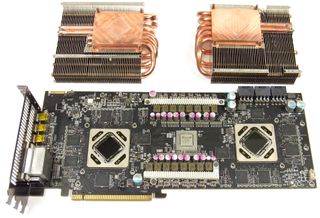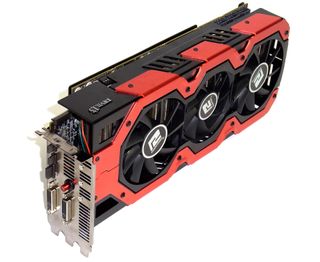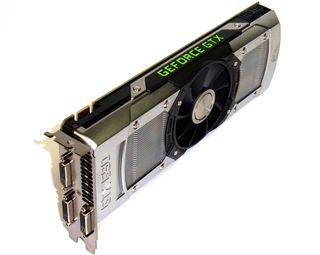Asus' ROG Ares II: Four Dual-GPU Graphics Cards, Compared
Earlier this year, Asus joined the extreme high-end graphics club with its own dual-Tahiti-based card, liquid-cooled and overclocked. You can't buy it anymore, but we got our hands on one and are adding it to our database of performance data.
The Competition: Two Dual-Tahiti Cards And GeForce GTX 690
The Elusive Champion: HIS Radeon HD 7970 X2
The extremely rare HIS Radeon HD 7970 X2 was never fully developed for the market, and consequently never hit store shelves. It employs a three-slot design necessary for cooling two Tahiti GPUs. Most noticeable, perhaps, are the two 9.5 cm fans that sit right over the card's twin graphics processors.

HIS decided to separate each GPU's power supply, going so far as to place them apart from each other on the board's PCB. In comparison, PowerColor uses one shared power circuit on its Devil13. In both cases, the total number of phases is the same: six for each GPU and two for each 3 GB chunk of GDDR5 memory. Magic R30 coils cut down on squealing.
HIS adds a twist to the cooling design. Its Radeon HD 7970 X2 doesn’t use one big sink like the competition, but rather two separate heat sinks that are each attached to one GPU and can be cooled independently. Both GPUs are connected through a Lucidlogix LT22102, which is unfortunately limited to PCI Express 2.0 signaling speeds.

The Beautiful Beast: PowerColor Devil13 Radeon HD 7990
PowerColor was the first to enter the market with its AX7990 6GBD5-A2DHJ Devil13. Since then, PowerColor’s parent company, TUL Corporation, introduced a similar design with slightly lower clock rates. Right now, that model is priced at $900 on Newegg, though it's out of stock. Hardware-wise, it's the same card. Only its frequencies are different.

Just like HIS' Radeon HD 7970 X2, PowerColor designed its Devil13 board from the ground up. It’s also a three-slot card, but instead employs a trio of cooling fans. The middle fan sits at an angle and has a diameter of 75 mm. The two larger fans each have a diameter of 90 mm.
Stay on the Cutting Edge
Join the experts who read Tom's Hardware for the inside track on enthusiast PC tech news — and have for over 25 years. We'll send breaking news and in-depth reviews of CPUs, GPUs, AI, maker hardware and more straight to your inbox.
Three eight-pin auxiliary power connectors and the slot together deliver up to 525 W, which is exactly the same as what we've already seen from HIS and Asus, and likewise insufficient when this board is under full load. We'll explore that in more depth shortly. On-board memory comes from Hynix; it can be manually overclocked to just over 1,500 MHz, though PowerColor ships it at a mere 1,375 MHz. PLX’s PCI Express 3.0-capable PEX 8747 connects the two GPUs with 16 lanes to each, along with 16 lanes to the slot interface.
The Voice of Reason: EVGA GeForce GTX 690
EVGA is only selling one version of the GeForce GTX 690. Nvidia's reference design is so good that there isn't much room for improvement. It's fairly thin and, at 1.04 kg, fairly light. Even after the GK110-based Titan's introduction, this dual-GPU board remains a flagship in the company's portfolio.

As we already know, the GTX 690 is built up on two GK104 graphics processors (the same ones used in Nvidia's GeForce GTX 680). Together, both GPUs wield 3,072 CUDA cores (1,536 per chip). The number of texture units and ROPs remain the same too, totaling 128 and 32 per GPU, respectively. Instead of its older PCI Express 2.0-limited NF200 bridge, Nvidia leans on PLX's PEX 8747 to connect its GPUs, enabling third-gen PCIe communication at very low latencies. Each GPU has access to its own 2 GB of GDDR5 memory, attached to an aggregate 256-bit memory bus. Bandwidth is identical to the GeForce GTX 680, at 192 GB/s.
Not everything is equal, though. The GeForce GTX 690's core clock rate is lower than the 680's (915 MHz compared to 1006). Similarly, the expected GPU Boost clock you'd expect to see from a GeForce GTX 690 is slightly lower as well (1,019 MHz). Two eight-pin auxiliary power connectors should deliver enough power for this card. Add in the interface's 75 W ceiling, and it has access to up to 375 W. The 690's predecessor, the GeForce GTX 590, used even more power and was rated at 365 W.
Current page: The Competition: Two Dual-Tahiti Cards And GeForce GTX 690
Prev Page Asus ROG Ares II: The Challenger Next Page Synthetic Benchmarks-
UltimateDeep I think you can get 2 690s or least 3 680s for the price of an ARES 2. The benchmarkers didn't evaluate Performance per watt, or Performance per dollar and the flipping size and length of each card which is the reason why I still stand by the GTX 690 in this article... For all these cards, all of that personally needs to be taken into consideration.Reply
I've nothing against the Dual 7970s but just want to let consumers be aware of the pros and cons especially the cards are not for the meek of wallet. -
dkcomputer Classic statement whenever you talk about AMD - "If only the software were better" or "When the software catches up" - how about "If only this component would be relevant when the software its made for exists"Reply -
PadaV4 So is the fps for radeon dual cards already divided by 2 or must the reader do it by himself?Reply -
ShadyHamster ReplyYou can't buy it anymore, but we got our hands on one and are adding it to our database of performance data.
If you live in Australia and have a spare $1900 you can still get your hands on one.
Most Popular

